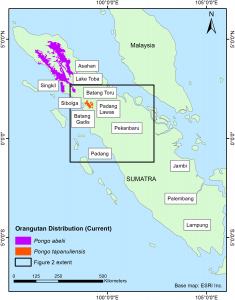It is one of the largest orangutans on the planet, but also the most critically endangered species of ape. It is the Tapanuli orangutan.
He is about to end up run over, his mother saves himIt is one of the largest orangutans on the planet, but also the most critically endangered species of ape. It is the Tapanuli orangutan (Pongo tapanuliensis) and lives in Indonesia. Its extinction, according to the US newspaper The Hill, may unfortunately be closer than expected.
In fact, there are fewer than 800 living specimens of this species, all concentrated in the mountains of Batang Toru (North Sumatra). Already classified as Critically Endangered (ie one step away from extinction) by the IUCN, now the alarm for theTapunuli orangutan (Pongo tapanuliensis) comes from a study published last January by the journal PLOS One, the remaining specimens would occupy less than 3% of the habitat they occupied at the end of the 800th century. The causes of the extinction of this orangutan are different and, of course, all attributable to man: deforestation, hunting, game trafficking and the project (for now still on paper) of a new hydroelectric plant that should be built on the river dell ' mountainous area. (Read also: Orangutans close to extinction due to palm oil (VIDEO))
If more than 1% of the adult population is killed, captured or relocated each year, this orangutan is set to become the first great ape species to become extinct in the modern era, according to a prediction by Professor Erik Meijaard - founder of the Borneo group. Futures, which tries to reconcile the conservation of wild life with sustainable development. The study, based on historical evidence from the region, showed that these monkeys were brought to their current habitat in the Batang Toru Mountains by hunters. The plateaus are not the ideal environment for the life of these animals, which nevertheless remain attached to them despite being able to move - at least in theory - within a variety of environments (including flat areas) to maximize their chances of survival.

The distribution of orangutans in Indonesia (ESRI, original copyright 2000)
The threat from the hydroelectric power plant would also disrupt this limited habitat. The 301 acres (122 hectares) intended for the construction of the center would block the merger between the different tribes of Tapanuli orangutans. This would lead to incest and limit the genetic diversity of the species, causing what scientists call "inbreeding depression" - basically a weakening of the species (lower reproductive capacity, increased mortality, inability to adapt to environmental changes, poor resistance diseases) which increases the risk of extinction. The works for the construction of the plant have been interrupted for now due to the health emergency in progress. The project also lost major funding from the Bank of China, so construction could stand still for many years. Professor Meijaard and his team hope this forced pause will push the local government to step back and consider ways to protect endangered orangutans.
Fonte: The Hill
You might also like:
- The real victims of the palm oil industry are the orangutans
- Orangutans self-medicate using the leaves as a pain reliever
- The rescued orangutan learning to climb a tree for the first time
- 27 monkeys, elderly and sick, killed by NASA in a single day instead of being entrusted to a sanctuary


























